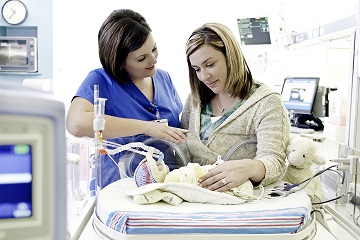Inexpensive gel helps nurses keep some newborns out of intensive care unit
Indescribable. That’s the word so many women use to sum up how it feels when she gets to hold her baby for the first time.
But this precious meeting is sometimes cut short by a common, and usually minor, issue if the baby has low blood sugar that he or she cannot stabilize on their own. This requires a trip to the Neonatal Intensive Care Unit for specialized care, temporarily separating mother and baby.
Or, at least it used to.
Thanks to a new practice throughout Texas Health Resources hospitals, there is a new way to care for neonatal hypoglycemia (low blood sugar) that doesn’t require a trip to the NICU. In fact, it only requires an oral gel.

“Nurses and caregivers are always looking for innovations, both big and small, that improve the health care experience for patients,” said Joan Clark, D.N.P., R.N., NEA-BC, CENP, FACHE, FAAN, senior vice president and chief nurse executive at Texas Health Resources. “I think it comes down to who caregivers are at heart: We want to take the best care of people we can.”
Typically, if a baby is born and either has risk factors for high blood sugar — such as mom being diabetic or the baby having a low birth weight or growth issues — or they have signs and symptoms of hypoglycemia, their blood sugar is tested. In most cases, babies with low blood sugar would be automatically sent to the NICU for intravenous glucose administration But earlier this year, Texas Health launched a pilot program for babies with low blood sugar to be given 40 percent oral glucose gel to stabilize their blood sugar instead of going to the NICU.
And the initial results are promising: At Texas Health Fort Worth, nurse researchers administered the oral glucose gel to 26 infants over the course of one month. Of those 26, only six still needed a NICU admission.
Perhaps the best part? It’s less expensive than treatment in the NICU. A lot less expensive.
The cost for an infant to stay in the NICU for low blood sugar can be up to $3,200 a day, depending on insurance coverage. The gel, which is typically used for diabetic adult patients but is safe for infants up to three doses, costs about $5 per tube.
“We love everything about this: It’s less invasive, it’s less expensive and it keeps the baby with mom — what’s not to love?” asked Lindsey Canon, director of Women and Infant Services at Texas Health Fort Worth. “And so far we’ve gotten great feedback from our moms.”
The idea came about in 2016 when a group of Texas Health staff nurses attended the Association of Women’s Health, Obstetric and Neonatal Nurses Convention where researcher Catherine Bennett, APN, presented her protocol for using glucose gel to treat neonatal hypoglycemia. Results of her research study, “Implementing a Protocol Using Glucose Gel to Treat Neonatal Hypoglycemia,” showed a 73 percent decrease in admission rates to the NICU for hypoglycemia.
“Our nurses came back to their various units or hospitals and they were very excited about this,” said Stephanie Eidson, clinical education specialist at Texas Health Resources University. “We knew this could be something that could be so impactful for moms and babies alike, so we started working on a plan to research and implement.”
That implementation rolled out in early 2017. As of November, the gel is used at all 11 of the wholly owned Texas Health hospitals where physicians who deliver babies are using the glucose gel intervention when medically appropriate for infants. And since Texas Health NICUs treated 3,426 babies in 2016 alone, that’s a big deal, Eidson said.
“It’s great when you can truly offer something better for mom and baby,” Eidson said. “We know how important it is for these new moms to be with their newborns and this was something we could do that made it better for everyone involved. This is the kind of improvement you dream of as a nurse.”

